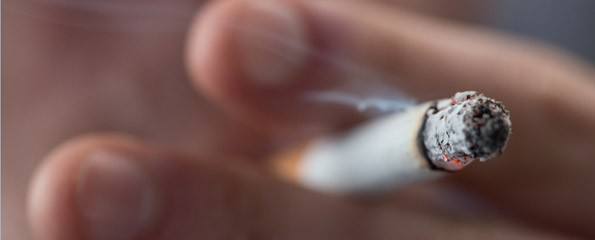What’s in a Cigarette?
- Structure of cigarettes
- Cigarette smoke
- Nicotine
- Carbon monoxide
- Tar
- Cigarette additives
- Flavoured cigarettes
Structure of cigarettes
Cigarettes are a small roll of porous paper containing a rod of chopped up tobacco leaf. Cigarettes are designed so that the tobacco can be smoked, by lighting the cigarette and breathing in the smoke. At the mouth end of the cigarette there is a second layer of porous paper (called tipping paper) and a filter. The tipping paper is designed to allow fresh air to infiltrate when the smoker inhales. This fresh air reduces the harshness of the smoke. The filter cools the smoke and reduces the flow of smoke out of the cigarette. Cigarettes also contain additives such as sugars and flavourings which are used to increase shelf life, control the rate at which the cigarette burns and control the delivery of the chemicals.
Cigarettes vary in strength, taste and intensity depending upon:
- The type of tobacco leaf that is used;
- Where on the tobacco plant it is taken from;
- The way the leaf is cured; and
- How the leaf is processed.
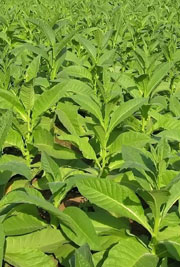 Tobacco leaves contain an addictive chemical called nicotine. The content of nicotine in the cigarette will depend upon the type and part of leaf that is used. The higher on the plant the leaf is taken, the greater the nicotine content.
Tobacco leaves contain an addictive chemical called nicotine. The content of nicotine in the cigarette will depend upon the type and part of leaf that is used. The higher on the plant the leaf is taken, the greater the nicotine content.
The most preferred tobacco leaf in Australia is Virginia tobacco. Virginia tobacco has a high sugar content. While this makes the smoke from the cigarette sweeter it also produces more acidic smoke. When the sugars burn a number of harmful acids are produced. In Australia blended tobacco leaf cigarettes are also available.
More information on Tobacco.
In 1987 labels were added to Australian cigarette packets which detailed the average yield of the main cigarette constituents, nicotine, tar and carbon monoxide, in each cigarette. From the content of tar, the cigarettes were categorised as ‘ultra light’, ‘light’ or ‘regular’. It was originally believed that low tar cigarettes would reduce the smoker’s exposure to hazardous chemicals. It has since been found that the ‘light’ cigarettes were delivering comparable doses of chemicals, were just as addictive as regular cigarettes and did not reduce disease or mortality rates amongst smokers. In 2006 the labels were removed when the Australian Competition and Consumer Commission determined these categories were misleading.
Cigarette smoke
Cigarette or tobacco smoke contains more than 4,000 different chemical compounds which are present in the solid phase, the gas phase or the liquid phase. The chemicals that make up the solid phase are tiny solid particles including phenols, nicotine and naphthalene. The major gases include carbon monoxide, nitrogen oxides and hydrogen cyanide and the liquid vapours include formaldehyde, methane, benzene, ammonia and acetone. The majority of these chemicals come from burning tobacco and the rest are a mixture of chemicals from the burning of the cigarette paper, the additives and the agricultural chemicals left from farming the tobacco leaves.
The tobacco smoke that comes out of a cigarette is made up two types of smoke; side stream smoke from the burning tip of the cigarette, and mainstream smoke that is delivered to the smoker via the filter or mouth end.
Tar, carbon monoxide and nicotine are the mainstream components of the smoke but they are not alone responsible for the deleterious effects associated with smoking and passive smoking. There are at least 60 chemicals in smoke which have been identified as carcinogens and 30 identified metals, some of which are radioactive.
Chemical compounds found in all phases of cigarette smoke have been associated with independent negative effects on the smoker, which means they produce their own separate damage. These are just some of these chemicals found in cigarette smoke:
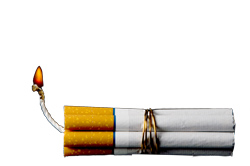 Benzene;
Benzene;- Benzo(a)pyrene;
- Ammonia;
- Formaldehyde;
- Hydrogencyanide;
- Acrolein;
- Dimethylnitrosamine;
- Non-nicotine alkaloids;
- Aromatic amines;
- Aromatic metals;
- Tobacco specific nitrosamines;
- Hydrogen cyanide;
- Nitrogen oxides;
- Aldehydes;
- N-nitrosamines;
- Ketones;
- Quinine; and
- Polycyclic aromatic hydrocarbons.
These chemical names may not mean very much to most people until they realise where else these chemicals are found and then it becomes evident just how harmful they are. The following is a list of some chemicals found in cigarette smoke and where else they are found:
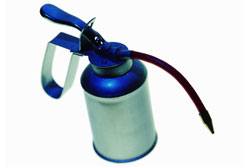 Carbon monoxide is one of the substances that is emitted from vehicle exhaust;
Carbon monoxide is one of the substances that is emitted from vehicle exhaust;- Nicotine is found in pesticide;
- Arsenic and DDT are used in insect poison;
- Hydrogen cyanide was used in the gas chambers in World War II and is currently used in rat poison;
- Acetone is paint stripper and is a component of nail polish remover;
- Ammonia is used in household cleaning products;
- Butane and methanol are found in fuel;
- Cadmium is a metal used in car batteries;
- Phenol is used in fertilisers;
- Naphthalene is a carcinogen used in moth balls; and
- Formaldehyde is used as a tissue and specimen preservative commonly found in science labs.
Nicotine
Nicotine is the addictive component of tobacco products. It exerts its addictive action by stimulating the release of the neurotransmitter dopamine in the brain, which happens within seconds of inhaling. Dopamine is a reward chemical, when it is released smokers experience a pleasurable feeling. Most smokers need to intake from 0.9 to 1.4mg of nicotine per cigarette in order to feel satisfied. Nicotine has also been found to:
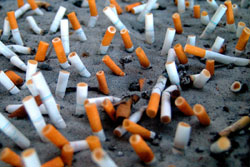 Alter the regulation of the blood brain barrier which in turn increases fluid (cytotoxic oedema) in the brain. This is believed to be the mechanism behind increased risk of stroke and worsening of stroke outcomes in smokers;
Alter the regulation of the blood brain barrier which in turn increases fluid (cytotoxic oedema) in the brain. This is believed to be the mechanism behind increased risk of stroke and worsening of stroke outcomes in smokers;- Have hazardous effects on the cardiovascular system;
- Contribute to the dysfunction of the walls of blood vessels (endothelium). Nicotine stimulates the production of free radicals which impair the vital ability of the blood vessels to dilate (vasodilation);
- In combination with carbon monoxide, nicotine is also responsible for reducing blood flow to your feet and hands, causing peripheral vascular disease (diseases of the arteries and veins of the limbs) which over time may lead to the need for amputation;
- Significantly increase nicotine levels in the brain, even from just short-term exposure to second-hand smoke;
- Play a role in the induction and progression of coronary heart disease (when the heart muscles become diseased), coronary artery disease (when plaque builds up inside the arteries) and heart attack. Nicotine also stimulates irregular heartbeats; and
- Stimulates processes which induce high blood pressure (hypertension) and arterial stiffness.
Carbon monoxide
Incomplete combustion of carbon-containing substances (such as wood and oil) produces carbon monoxide. In the case of cigarettes the carbon-containing substance is tobacco. Other sources of CO include:
- Cooking stoves;
- Heaters;
- Fireplaces; and
- Engines.
Carbon monoxide causes damage to the lungs by depriving the body of oxygen. Oxygen is displaced from haemoglobin (Hb) due to the competitive binding of carbon monoxide. Hb is responsible for transporting oxygen through the body therefore if oxygen is unable to bind to Hb as a result of carbon monoxide it will reduce oxygen delivery to tissue. When body tissues do not have enough oxygen it causes a serious condition called hypoxia. Smokers can have as much as 10 times as much carbon monoxide in their bloodstream as non-smokers. Exposure to large quantities of carbon monoxide is fatal.
Tar
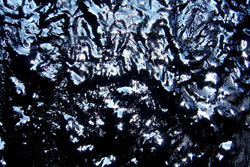 Tar is a mixture of the compounds in cigarette smoke which condensate (turn from a gas to a solid) once in the lungs to form a sticky brown substance, this is the cigarette smoke condensate. Tar is the part of cigarette smoke which causes the yellow-brown stains on teeth and fingers. Tar is made of nitrogen, oxygen, hydrogen, carbon dioxide, carbon monoxide, and a wide range other chemicals.
Tar is a mixture of the compounds in cigarette smoke which condensate (turn from a gas to a solid) once in the lungs to form a sticky brown substance, this is the cigarette smoke condensate. Tar is the part of cigarette smoke which causes the yellow-brown stains on teeth and fingers. Tar is made of nitrogen, oxygen, hydrogen, carbon dioxide, carbon monoxide, and a wide range other chemicals.
These chemicals have short and long term effects on health. The short term effects include coughing and shortness of breath.
The detrimental long term effects of tar have been known since the 1950s when tumours grew on mice after their skin had been painted with the tar from cigarettes. The chemicals in tar are the main causes of lung and throat cancer among smokers. Part of the cancer causing effect of tar is because it interferes with immune cell cycle progression which results in significant reductions in immune responses. This in turn increases the incidence of tumours and respiratory tract infections.
The tar that remains in the lung causes cells to die. Some of the cells that are destroyed are cilia. Cilia are little hair-like structures that help move mucous out of the lung. Over time, loss of this cell function can lead to emphysema.
While in the past a lot of study and emphasis has been placed on different strength cigarettes, it has since been found that one milligram of tar from one cigarette will contain equal amounts of carcinogens and cardiovascular toxicants as one milligram of tar in the next cigarette. All cigarettes are dangerous and cause serious health consequences for you and those affected by the smoke from your cigarette.
Cigarette additives
Cigarette additives are used to:
- prolong shelf life;
- control the rate of burning;
- help in cigarette manufacture;
- control how much nicotine is delivered;
- add flavour; and
- reduce the harshness and irritation of cigarettes.
There are 5 main types of additives including processing aids, combustion aids, flavours, humectants and nicotine controllers.
 Ammonia compounds, carbon dioxide and ethyl alcohol are used to make the cured tobacco less brittle and therefore make it easier to manufacture.
Ammonia compounds, carbon dioxide and ethyl alcohol are used to make the cured tobacco less brittle and therefore make it easier to manufacture.
Ammonium, sodium phosphate and sodium and potassium citrate are used to treat the cigarette paper which works to control the rate at which the cigarette papers burns. Additives are also used to control the temperature of the burning cigarette.
Humectants include sugars, glycerine and glycol compounds. They are used to keep the tobacco moist.
Additives are used to aid the delivery of target doses of nicotine. Nicotine’s addictive potential can also be increased with the addition of ammonium salts and acetaldehyde.
Liquorice, cocoa, honey, fruit spices or fruit extracts can be used to improve the taste of cigarettes making them more palatable and appealing, especially for first-time smokers. Chemicals contained in liquorice, coffee and cocoa dilate the airways and as a result the smoker will achieve greater doses of nicotine and tar. Menthol can numb the throat and make the smoker less aware of the harsh effects of the smoke and even promote a feeling of “freshness” in the mouth after a cigarette. All flavours, especially sugars, mask the noxious taste of tobacco and the bitter taste of nicotine.
Additives are regarded as “safe” substances by tobacco industries. However, what needs to be taken into account is that these ingredients are inhaled into the lungs rather than ingested, which is not safe. Furthermore, additives contain chemicals whose effects may not be harmful if ingested individually but when added to cigarettes can heighten the powerful addictive effects. For example, some additives stimulate nicotine receptors and therefore render smokers’ brains more receptive to the addictive effects of the chemical. Additives aid in making the cigarette an attractive option which increases the difficulty of quitting.
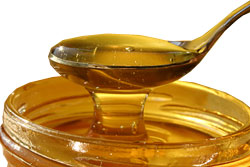 Cigarettes are not classified as drugs or food and therefore do not have standards placed on them in order to control the agricultural chemicals that are used in farming the tobacco and the amount of chemicals that are left on the plant once they have been farmed. Agriculture additives may include fungicides, fertilisers, insecticides and herbicides.
Cigarettes are not classified as drugs or food and therefore do not have standards placed on them in order to control the agricultural chemicals that are used in farming the tobacco and the amount of chemicals that are left on the plant once they have been farmed. Agriculture additives may include fungicides, fertilisers, insecticides and herbicides.
Currently tobacco companies in Australia have a Voluntary Agreement with the Government Department of Health and Aging which protects manufacturer’s trade secrets. The government has a list of the ingredients in each brand of cigarettes but under the agreement this information is not made public.
Flavoured cigarettes
There are some cigarettes which are designed to be dominated by a flavour. Menthol and confectionary/liqueur cigarettes are the two major flavoured varieties.
Flavoured cigarettes can mask the intensity of the tobacco to an extent that smokers will retain the smoke for longer without breathing out and as a consequence receive greater levels of nicotine. The harshness of the tobacco smoke is also masked which makes it easier to tolerate cigarettes and less likely to recognise the dangers of smoking.
Currently fruit and confectionary cigarettes are banned in a number of Australian states and it appears that other states will follow suit.
More information
 | For more information on smoking and its health effects, and some useful tools, videos and animations, see Smoking. |
References
- Tar Information Sheet [online]. Quitnow 2006 [cited Jun 2010]. Available from: URL: http://www.quitnow.info.au/internet/quitnow/publishing.nsf/Content/tar
- Stellman SD, Djordjevic MV. Monitoring the tobacco use epidemic II: The agent: Current and emerging tobacco products. Preventive Medicine. 2009; 48(1 Suppl): S11-5.
- Adamopoulos D, Argacha JF, Gujic M, Preumont N, Degaute JP, van de Borne P. Acute effects of nicotine on arterial stiffness and wave reflection in healthy young non-smokers. Clin Experiment Pharmacol Physiol. 2009; 36(8): 784–9.
- Paulson JR, Yang T, Selvaraj PK. Nicotine exacerbates brain edema during in vitro and in vivo focal ischemic conditions. J Pharmacol Exper Therapeut. 2010; 332(2): 371-9.
- Department of Health and Ageing. Fact Sheet: How smoking harms your health [online]. Australian Government Department of Health and Ageing. 2004 [cited Jun 2010]. Available from URL: http://www.health.gov.au/internet/main/publishing.nsf/Content/D87C1389F867B087CA25774B007C58E2/$File/tobharm.pdf
- Yee BE, Ahmed MI, Brugge D, et al. Second-hand smoking and carboxyhemoglobin levels in children: a prospective observational study. Pediatr Anesthes. 2010; 20(1): 82–9.
- Palozza P, Serini S, Trombino S, Lauriola L, Ranelletti FO, Calviello G. Dual role of b-carotene in combination with cigarette smoke aqueous extract on the formation of mutagenic lipid peroxidation products in lung membranes: dependence on pO2. Carcinogenesis. 2006; 27(12): 2383–91.
- Frazer-Abel AA, McCue JM, Lazis S, Portas M, Lambert C, Freed BM. Cigarette tar phenols impede T cell cycle progression by inhibiting cyclin-dependent kinases. Molecular Immunology. 2007; 44(4): 488-93.
- Balakumar P, Kaur J. Is nicotine a key player or spectator in the induction and progression of cardiovascular disorders? Pharmacol Research. 2009; 60(5): 361-8.
- Tobacco in Australia: The construction and labelling of Australian cigarettes [online].The cancer council, 2010 [cited Jun 2010]. Available from: http://www.tobaccoinaustralia.org.au/chapter-12-tobacco-products/12-3-labelling-of-tar-nicotine-and-carbon-monoxide
- Action in smoking and health: Essential information on what’s in a cigarette [online]. ASH 2010 [cited June 2010]. Available from: www.ash.org.uk
- Background brief: What’s in cigarettes [online].Quit 2003 [cited July 2010]. Available from URL: http://www.quit.org.au/downloads/BB/05What.pdf
- The truth: What’s in a cigarette? [online] MDSI 2008 [cited July 2010]. Available from URL: http://www.mdsi.org.au/smoking_matters/SmokingMattersA4Flyer_Web.pdf
- Make smoking history: Cigarette ingredients [online]. Cancer council WA, 2009 [cited July 2010]. Available from: URL: http://www.cancerwa.asn.au/resources/2009-12-22-Cigarette-ingredients.pdf
- Ipsos-Eureka social research institute: Cigarette ingredients and emissions disclosure [online]. Department of health and aging, 2009 [cited July 2010]. Available from: URL: http://www.health.gov.au/internet/main/publishing.nsf/Content/
Dates
Tags
Created by:

 Login
Login